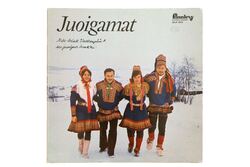When one talks about jazz and folk music in a Nordic context today, it is mainly albums such as Jazz på Svenska (Jazz in Swedish) (1964) or Østerdalsmusikk (Music from Østerdalen) (1975) that come to mind. Yet around the same time that these recordings were made, in Sápmi and Karelia, Sámi joikers and Finnish jazz musicians were in the process of creating a new sonic genre based on a fusion of jazz and Sámi joik. The result was often referred to as Modern Joik, Jazzjoik or New Joik, and laid the foundation for the large presence of jazz in Sámi music today. We travelled to Imatra, a small town 270 kilometres east of Helsinki, right on the Russian border, to meet two of the most important protagonists in the new joik movement: Seppo “Báron” Paakkunainen and Esa “Goahtelaš” Kotilainen.
 |
| Joikuja. Foto: Ulf Carlsen |
Before getting to Imatra, though, it’s important to introduce the third protagonist in this story—Nils-Aslak Valkeapää, also known as Áillohaš or Áilu (1943–2001). Áillohaš’ breakthrough came in 1968 when his debut album Joikuja (Joiks) was released by the Finnish label Otavan Kirjallinen Äänilevy, a literary sub-label for the publishing house Otava. Despite the modest 10-inch format, the album contained 22 tracks arranged by Finnish composer Kari Rydman with Martti Niskala as guitarist, in which Áillohaš’ songs and joiks were dressed in folky sounds and hints at contemporary music. Joik, which had traditionally been performed a cappella in private settings, had found a new, modern expression that could be broadcast over radio and performed on concert stages. Joikuja also introduced Áillohaš’ distinct style of joik, which draws from crooning, opera and even Qawwali music. In the liner notes to the album, Áillohaš writes that he has strived to capture the entire life process in his joik and the fact the he was the first one to perform the modern joik was just a coincidence: “I have faced resistance from two sides for my joik. First from the believers—they consider joik to be a sin. The other resistance came from a cultural romantic perspective—they felt I was faking the pure joik. Since I do not consider it necessary to be accused of being sinful or counterfeit joik, I have accepted modern joik as a good name.”
Even though Joikuja came out only a year after the city of Guovdageaidnu/Kautokeino had introduced a ban on joik, Áillohaš saw that a new scene of joikers were on the rise, a generation of talented and unprejudiced youth. And in the years to come, much of Áillohaš’ time was spent recording and promoting this scene. This resulted in collaborative LPs such as Juoigamat (Joiking) with Johan N.P. Eira (a.k.a. Duvvá), Ellen Anne Buljo og Laila A.M. Hætta (1973), De čábba niegut runiidit (Then Beautiful Dreams Shoot Up) with Åsa Blind and Jaakko Gauriloff (1976) and Duvvá, Áilen Niga Elle Ja Áillohaš (Duvvá, Áilen Nigá Elle and Áillohaš) (1976).
Around the same time as Áillohaš’ modern joik recordings started to circulate, bass player Edward Vesala and saxophonist and flutist Seppo Paakkunainen formed the band Karelia Group. Both were already names on Helsinki’s burgeoning soul, beat and jazz scene, but now wanted to create a band that preserved the genuine sound and feel of Finnish traditional music mixed together with modern musical styles. In press images, the band posed in traditional Karelian costumes and on stage they played on clarinets, flutes and trumpets constructed from birchbark. A few years later, Finland’s synth guru Esa Kotilainen, known as a keyboard player in Wigwam and Tasavallan Presidentti, became a regular member of Karelia Group. And when Edward Vesala signed with ECM, Paakkunainen and Kotilainen continued their exploration of Finnish traditional music.
The Karelia Group not only excavated Finnish traditional music, they also began to explore Sámi music. On their debut album Suomi Pop 1 there are two song titles that stand out: “Kaksi Joikuja” and “Joiku Blues.” And it is because of these tracks that Áillohaš got to know the musicians that he later would name “Báron” and “Goahtelaš.” The story goes that one day when Áillohaš was in his house in Beattet/Pättikkä listening to the radio, the sound of two long-haired Finnish jazzers howling out joiks from Anár/Inari and Kárášjohka/Karasjok burst out of the speakers. Áillohaš wondered who these crazy musicians were and decided to make a phone call to Paakkunainen. And so began their collaboration that would last for nearly 30 years, right up until Áillohaš’ death in 2001.
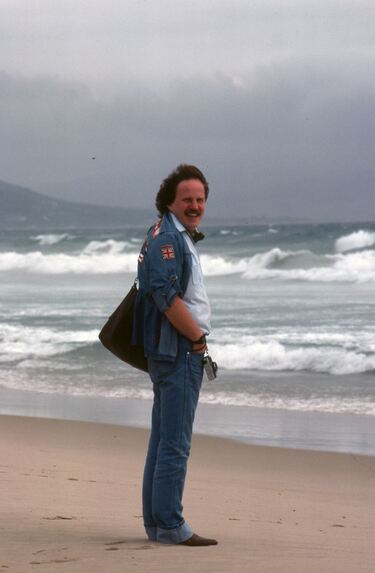 |
| Seppo |
After landing Helsinki and finding our rental car, we plot Imatra into the GPS. We are going to take Route 6 that winds northeast in the border area between Finland and Russia previously known as Karelia. Our destination is Imatran Valtionhotelli, an art noveau castle built in 1903 to host rich tourists from St. Petersburg. At this hotel, where everyone from composer Jean Sibelius to painter Akseli Gallen-Kallela stayed, we meet Báron and Goahtelaš.
Geir: So, how did you get a hold of the joiks that you used for Suomi Pop?
Seppo: We found them in the archive of the Finnish Literature Society in Helsinki.
Lars: They kept notations of the joiks?
Geir: Or archival recordings?
Seppo: They had notations and some old joik recordings that we made copies of. We listened and tried to imitate them as best as we could. So, where I’m imitating joik it sounds like [Seppo starts joiking in a low, dark pitch] and the parts where Edward is doing it, it sounds like [Seppo joiks in a very high, pointy tone]. Ha ha! And Áilu must have been thinking to himself: Who are these crazy chaps? So when Áilu was booked to do a recording for our national broadcaster YLE, he asked the producer to contact me to do the arrangements. So we did this gig together in 1972, and that was the first time I heard live joik, and the first time I met a Sámi. The next day we went for a walk and Áilu was talking to me about his country and pop music, and about his joik. I said to him, “I think you should concentrate on joik, in the same way I was into old music from Karelia.” And then we made a plan that when autumn came I would bring my family to Beattet to visit him. And we travelled north in October and stayed a week, and this was the first time we started planning how to combine instruments with joik. Áilu was very interested in jazz and I was mainly a jazz musician. So we decided, Okay, let’s try to combine, to put together, joik and jazz.
Lars: I’ve read that the next step was that you brought some jazz musicians to Ochejohka/Utsjoki to arrange a workshop with a group of joikers?
Seppo: The first sound experiments happened in Ochejohka in the summer of 1973, with Ilpo Saastamoinen and Esko Rosnell. Ilja was playing guitar and Esko brought darabouka, a goblet drum. I was playing the flute, and a bunch of joikers, including Áilu, jammed together with us. Then we started to experiment and improvise rhythmically with joik. Not with real jazz. No. Because jazz is jazz and joik is joik.
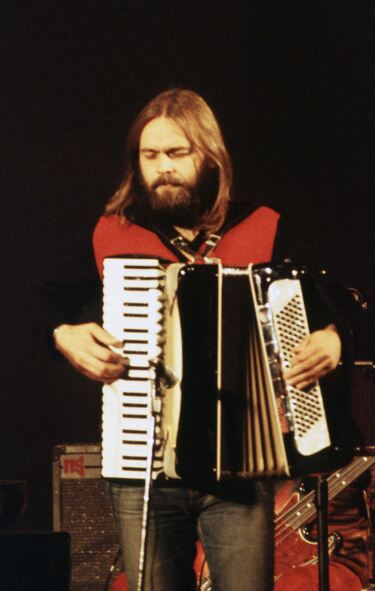 |
| Esa |
Lars: When you met Áilu in 1972, had you heard of him before?
Seppo: I had no idea. Nothing. I think it is as simple as this; the attitude toward Sámi people in Finland is that they are primitive and that they are not respected as normal people, they are not completely Finns. So people were not so interested in Sámi culture at this time.
Esa: I had heard rumours that Áilu was doing some sort of restaurant cabaret at various mountain hotels in northern Finland. He was certainly a tourist star in Kilpisjärvi doing singalongs with his guitar and everything. I was also part of this “restaurant circle,” and in this milieu he was famous.
Lars: It was five years between the experiments in Ochejohka and when you released the first jazz joik LP together, Sámi eatnan duoddariid (Wide Open Tundra of Sápmi) in 1978. In this period, Seppo, you also produced two albums with Áilu: Juoigamat (Joiking) in 1973 and Vuoi, Biret Maaret, Vuoi! (Oh, Biret Máret, Oh!), recorded in 1974, but released in 1977. Tell us a little about these two early collaborations.
Seppo: Because of the Karelia Group LP in 1971, I had good contact with one of the most important Finnish composers, Toivo Kärki. He was leading the record label Finnlevy’s domestic production and was also playing and composing jazz. So, it was easy for Áilu and me to get some LPs released by Finnlevy. Vuoi came out at a time when Áilu was still very into country and western, writing pop and protest songs. The album contains songs not joiks. It’s more like French chansons. Áilu wanted to do this, and one must also understand that the group Deatnugátte Nuorat was popular at this time.
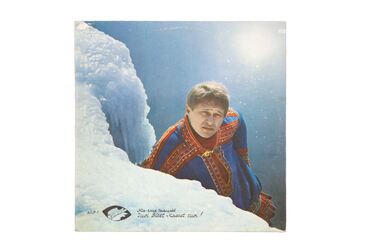 |
| Vuoí, Bíret Máret, Vuoí. Foto: Ulf Carlsen |
Geir: Du nevnte at Áilu var interessert i jazz, nevnte han noen favorittartist eller sjanger?
Seppo: Nei, ikke som jeg vet om. Jeg tror han hovedsakelig hadde hørt det på finsk radio. Men allerede før vi møttes i 1972 rakte han rundt i Helsinki og opptrådte på en seilerklubb og restaurant som het Klippan, som lå på den lille øya Luoto utenfor Helsinki sentrum. Her spilte han med saksofonisten Esa Pethman og hans jazzgruppe. Også var det en annet forsøk med Christian Schwindt, en berømt trommeslager. Men tilbake til Ochejohka. Det jeg husker fra all den jamminga var at trommisen Esko Rosnell, var litt for tung, og spilte veldig høyt. Og når en eldre mann begynte å joike, så startet Rosnell å telle opp og rope: ”1-2-3-4-5-6-7! Hei folk – det går til sju!” Og jeg bare svarte: «Ikke tell, bare spill!» Fordi hovedfokuset ditt når du arbeider med artister innenfor etnisk musikk eller folkemusikksangere skal være å lytte. Så etter Ochejohka så dro jeg og familien til Guovdageaidnu/Kautokeino for å spille en konsert i påsken 1974, og så reiste jeg og Áilu til København hvor vi opptrådte på Jazzhus Montmartre. Her satt Ole Koch-Hansen inn på piano, Bjarne Rostvold på trommer og Allan Botschinsky på trompet.
Geir: Hvordan var mottakelsen på Jazzhus Montmartre?
Seppo: De likte det. Selvfølgelig var det helt nytt, og når noe er nytt og eksotisk så er publikum veldig i ‘hva-er-dette-modus’. Etter Ochejohka og København hadde vi mange konstellasjoner som gjorde ulike eksperimenter for å forbinde frijazz og rytmisk jazz med joik. Men spol frem til 1978, da Áilu og oss ga ut vårt første album Sámi eatnan duoddariid, da var det ikke lenger jazz vi holdt på med. Vi hadde gått gjennom flere faser, og så gikk vi bort fra det. Nei, nei, det skjer ikke, det fungerer ikke med jazz. Men i Norge kalte de det jazzjoik okke som …
Lars: Hva kalte dere det? Nyjoik, urfolksjazz, improjoik?
Seppo: Nyjoik var en betegnelse som kom senere. Joik og jazz var helt ok det, vi kunne leve med det.
Lars: Når dere møttes i Ochejohka, hva var det dere fant ut, hva var de soniske oppdagelsene?
Seppo: Vi forsto at joikere, når han eller hun inhalerer, må ta en pause før de kan starte på den igjen. Så det var umulig å ha en kontinuerlig rytme som backet dem. Men når vi startet å gjøre ting annerledes, så lærte joikerne seg andre triks. Litt etter litt så prøvde vi ikke å gjøre jazzvokal, finne hverandres tempo eller være beatorienterte.
Lars: Mot frijazz?
Seppo: Nei, improvisasjon. På Jazzhus Montmartre når Botschinsky satt inn med oss, så spilte han veldig jazzy og jeg tenkte ‘nei! nei! nei!’ men sa ikke noe. Men samtidig er det viktig å huske at fjellsamisk joik bruker pentatonisk skala og at en del jazz i USA på 1960- og 70-tallet også var pentatonisk. Men i stedet for bare å benytte jazz med joik så utviklet vi det ved å blande inn etniske rytmer, rhythm and blues, afrikanske elementer, indisk musikk. Og en annen ting vi lærte fra eksperimentene var at når joikerne beveget seg oppover i toneskalaen og jeg prøvde å følge dem med fløyte eller saksofon, så bare fortsatte og fortsatte de oppover, som igjen førte til at jeg måtte stoppe, ta en pause og så komme tilbake. Og når Esa spilte trekkspill og joiken begynte å gå oppover og oppover, så måtte han gå over til å spille clusters.
Esa: Dere skal vite at Áilu elsket moog! Med ibratopitchen på det instrumentet er veldig lik joik. I tillegg kunne jeg lage hvaler, fugler, vind og hav med synthene mine og det elsket han. Mine synther la til mer farge på joiken. Jeg lagde farger… Og improvisasjoner…
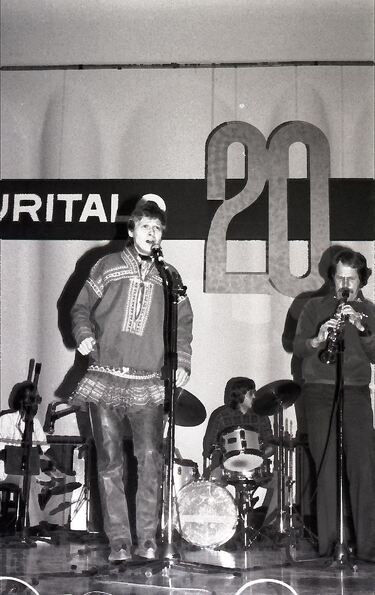 |
| Nils-Aslak og Seppo, Kulttuuritalo i Helsinki 1978. Foto: Ukjent |
Geir: You said that Áilu was interested in jazz, did he mention some favourites or favourite genre?
Seppo: No. I think he mainly had heard it on Finnish radio. But it is interesting that even before we met up in 1972, Áilu had been in Helsinki and performed at a sailing club and restaurant called Klippan with saxophonist Esa Pethman and his jazz group. There was also another attempt with Christian Schwindt, a famous jazz drummer. But, back to Ochejohka. What I remember from all that jamming was that when an older man started to joik, Rosnell started counting and said: “1-2-3-4-5-6-7! Hi people - it is going to seven!” And I just replied: “Don’t count! Just play!” Your main focus when working with artists in the field of traditional music or folk singers should be to listen. So after Ochejohka I went to Guovdageaidnu with my family to play a concert there during Easter of 1974, and then Áilu and me went to Copenhagen where we performed at Jazzhus Montmartre. Here Ole Koch-Hansen played piano, Bjarne Rostvold drums and Allan Botschinsky the trumpet.
Geir: How was the reception at Jazzhus Montmartre?
Seppo: They liked it. Of course it was very new and exotic to them and they are very in a “what is this?” mode. After Ochejohka and Copenhagen we had many constellations that did different experiments to combine free jazz and rhythmic jazz with joik. But fast forward to 1978, when we released our first album Sámi eatnan duoddariid. Then it was no longer jazz. We had gone through several phases and then walked away from it. No, no, it doesn’t happen, it doesn’t work with jazz. But in Norway, they called it jazzjoik anyway.
Lars: What did you guys call it? New Joik, Indigenous Jazz, Impro Joik?
Seppo: New Joik was a term that came later. Joik and jazz was cool to us, we could live with that.
Lars: When you met in Ochejohka, what did you find out?
Seppo: We learned that when the joiker, whenever he or she inhales, they need to take a break before they can start again. So it was impossible to have a continuous rhythm backing them. But when we started to do things differently, the joikers also learned some other tricks. Little by little, we didn’t try to do jazz vocals, find each other’s tempo or to be beat oriented.
Lars: It developed towards free jazz?
Seppo: No, improvisation. At Jazzhus Montmartre when Botschinsky sat in with us, he played very jazzy and I thought, No! No! No!, but I didn’t say anything. At the same time, it is important to remember that Sámi joik uses the pentatonic scale and some jazz in the 1960s and 1970s was also pentatonic. But instead of just using jazz with joik we developed it further by blending in rhythm and blues, African elements and Indian music. And another thing we learned from the experiments was when joikers started to go higher in pitch and I tried to follow them with flute or saxophone, then the problem was that they just continued doing so, which led to me having to stop, take a break, and then come back. And when Esa played accordion and the joikers started going up and up, he had to play clusters.
Esa: You know, Áilu loved the moog! With the vibrato switch on that synthesizer it is very easy to follow joik. In addition, I could make whales, birds, wind and sea with my synths and he loved it. My synths added more colour to the joik. I made colours...and improvisations....
Lars: Did Áillohaš change his way of joiking to blend with your music?
Seppo: Of course, it means something to joik together with a saxophone. It is a form of exchange of cultural characteristics and traditions. Jazz traditions had to be adapted to the joik and vice versa. This triggered new ideas for Áilu and further developed his joik. Eventually, he would always bring with him another joiker on stage as he no longer regarded himself as a traditional joiker.
Esa: During the concerts, when we were improvising, Áilu walked over to a small cassette player that he had on stage. He held it up to his ear to hear which joik was coming up next. This is because some joiks are so similar! And what happened when Áilu composed a new joik was that it always changed a little from time to time, it was never the same. This is very natural and nice, why should it be the same every time? After a while, we also decided to mix joik with baroque music. We had a session where Áilu joiked and we backed him up with baroque-style cello and violin. But this session was never recorded.
Geir: But it must have also been a way of testing out different things? Maybe something appeared?
Seppo: When we mixed baroque music with joik, Áilu liked it. I think this was because he was educated in classical music when he took his education as a teacher in Giemajávri/Kemijärvi, Finland. At the seminar he learned to sing, studied piano and guitar, and performed works such as Musorgsky’s The Song of the Flea. He knew how to do this; he mastered it. And around 1980 he came to me with a cassette with Dvořák’s Symphony No. 9 From the New World and asked me if I could create a symphony in the same spirit, a joik symphony, where I used his joiks and some of my own material. I told him: “If this is an order, I’ll do it.” I copied Dvořák, Debussy…there’s a little Sibelius in there also…and then the rest is me. The idea was that the Sámi people also needed a symphony, a joik symphony. Symphony no. 1 Sámi Luondu, Gollerisku (Sápmi’s Nature, Golden Brooch) was later recorded with the Tallinn’s chamber orchestra and released in 1992.
Geir: How did Áilu react to the results? Was he happy with the music?
Seppo: He never really complained. I am sure he liked it.
As we all need an oxygen break, we take a stroll outside to see the famous Vuoksi river. As we retreat to the hotel, Seppo wants us to go by the parking lot to show two paintings by Áillohaš he has brought with him. He pops the trunk and unloads a rare painting from 1972. It stems from a brief, intense period, where Áillohaš painted expressive landscapes and fauna with zealous strokes and colours. He then brings out another work from the trunk, a darker and unusual drawing that turns out to be closely linked to music.
Seppo: This painting was made during a flight to the United States in November 1982, in relation to the Scandinavia Today tour. During the flight Áilu managed to spill a glass of red wine over the set list he had made for the next day’s concert. But instead of wiping it up, he began to paint with the red wine using his fingertips, and then with pen on the paper.
Lars: Very rare…
Geir: Something we’ve never seen before!
In 1978, an important event occurred in this musical collaboration. Together Áillohaš, Seppo and Esa founded the label Indigenous Records, with the purpose of releasing traditional Sámi and Karelian music. The company, based in Beattet and with a studio in Helsinki, was to release seven albums between 1978 and 1982.
Lars: Tell us about the creation of Indigenous Records.
Seppo: Me and Esa met in 1975 when we both played in Jukka Tolonen’s travelling band. Around the same time we also recorded with Jukka, Pekka Pohjola and Esko Rosnell at Marcus Music Studio in Stockholm. Me and Esa started talking together about the quality of the recordings made by Marcus Music, and the fact that in Finland it was not possible for us to get the sound we wanted, the real pop, rock and jazz fusion sound, that Weather Report sound. When I told various labels that we were going to make a joik and jazz album, no one seemed interested. So we started thinking that maybe we could establish a record company that could release jazz and joik. Áilu had some money from a house sale in Gárasavvon/Karesuando, which was injected into the company, and then we borrowed money from a bank with my wife as a guarantor. We bought some equipment and rented a space for the studio in Käpylä, outside Helsinki. My father was summoned to make a very thick door so no one could break in, and he also built a listening room and fixed the ceiling. So when we started recording the first album, Sámi eatnan duoddariid, nothing was really finished. I remember Áilu with headphones on and Markku playing bass, while Esa was on the floor soldering wires. And we were like: When can we start? And then the title track from that LP later became the unofficial Sámi national anthem
Lars: Who had the idea behind Indigenous Records’ profile?
Seppo: It was Áilu’s idea. He had worked as a cultural coordinator for World Council for Indigenous People in Canada in the mid-1970s and was dedicated to this cause. He also came up with the name – a name no one in Finland could pronounce! IR released three albums with Áillohaš/Áillohaččat and some albums with Karelian music. After the first album, in 1978, Esa and Áilu travelled to the small Skolt Sámi village of Čeʹvetjäuʹrr/Sevettijärvi to record an LP of eastern Sámi music. It was important for them to record the joik in its natural surroundings. The album Sue’nn’jel Lee’ud – Muistoja Suonikylästä was released by IR in 1979.
Lars: But with headquarters in Beattet, how did you get distribution?
Seppo: That was our main problem. You know, we were three musicians, three artists who ran a company together, and we each owned a third. Áilu, who lived in Beattet, was the art director; Esa was in charge of the studio; and I did the rest. I remember packing these [Seppo holds up a fistful of Indigenous Records LPs], each and every one, and then going to the post office.
Esa: If we were lucky, someone said: “Can we buy two copies?” But mostly we sent records out one by one. And sometimes we even just took my car and delivered right to the doorstep. But if an order came from abroad it was half price so we didn’t make any money!
Lars: One thing that stands out in your collaboration for me is the live part. It seems that you had a penchant for developing special multimedia performances that stand out as independent works. Take, Sápmi lottážan (Sápmi, My Dear Little Bird), which was developed for UNESCO’s General Conference in Belgrade in 1980 and where poetry, joik, jazz and field recordings, blended with projections of Áilu’s photographs of Sápmi’s nature. During 1984-85 you toured with the multimedia performance Ruoktu Váimmus (Trekways of the Wind), and during the run-up to the Lillehammer Olympics in 1994, you developed a concept of “poetry concerts” that included painting live during each gig. How did this performative part come about?
Esa: Áilu had something like two thousand photographs in his house. So it was he who came up with a visual story line, for each concert he wrote a story with his poems and slides. He also wrote down, sort of like a libretto, a visual sketch in words. And then he programmed two slide projectors to display the images in a specific order. But even though we planned beforehand, there was a lot of improvisation in these performances. We improvised in the spirit of the pictures and poetry.
Seppo: Áilu had a special presence on stage when he joiked and recited. He captured the audience. I have read about scientists using the term “bioenergy” to explain certain people’s radiance. If this is the case, I can tell you that Áilu had a very high degree of bioenergy….
Lars: And when Áillohaš was named Olympic artist for the Sámi people in 1991, you had to participate in the opening ceremony that was broadcast to millions….
Seppo: Áilu came one day and told us: “Hi guys, we are going to perform in Lillehammer. You know, I compose the joik and then you do the background, and we will all stand on a ski jump platform down there.” Me and Esa were happy that we got to be a part of it, but the first version of the performance was us sitting with our gear in a large ice building, almost like a Lásságámmi made of ice or something similar. And then Áilu would come joiking into the arena with skis on his feet, drawn by a reindeer herd. At first we were told that our performance could last for ten minutes, but gradually this went down to five minutes. And when they told us it had to be three minutes, Esa and I were no longer there. So during the opening ceremony, we sat in the stands with the rest of the audience and froze!
Esa: I asked the organizers; can we create an eight-track system for the opening? Yes, we could do that. Then the eight-track was reduced to a four-track system that could be controlled with a joystick. But when the opening ceremony day came it was mono! A year before, there had been eight tracks!
Seppo: A part of the deal was that we would do a promotion tour in former Olympic cities. For each of these concerts, Áilu painted a work live on stage, which eventually became part of his exhibition at Maihaugen in 1994. Finally, the album Dálveleaikkat (Winter Games) was released in 1994. We received a good package price for everything, but the story ended with us sending the Finnish Musicians’ Association after the Lillehammer Olympics to get our fee – they totally forgot to pay us!
Esa: We were part of the Finnish Olympic squad, but we played Sámi music and showcased Sámi culture.
Lars: In 2010, DAT released the record Alit Idja Lahkona (Blue Night Moving Closer). It consists of live recordings with you two and Áilu from concerts in Málatvuomi girkus (Målselv Church) and the Easter festival in Guovdageaidnu in 1992. This record is very different from your other collaborations, as Áilu sings self-written lyrics to old spiritual melodies. Can you tell us about this last record?
Seppo: Áilu’s interest was in old spiritual songs made in the Arctic Sea region. Áilu collected various recordings from museums and archives in Sápmi. He gave us those recordings to do transcriptions, and then the arrangements were done partly as a teamwork. We had a plan to record Alit Idja Lahkona in a studio also, but…
It is getting late and Seppo has to head back to his home in Uukuniemi, deep down in the Karelian land. On our way back to Helsinki, we give Esa a lift to Kuusankoski. In the car we ask if it’s okay to put on some of the music he made with Áillohaš and Seppo. He nods, but also explains that he never listens to his own music after it’s released, he looks ahead and has still so many projects he wants to do. But when the song Sámi eatnan duoddariid plays, we are all a bit blown away by the fact that Sápmi’s alternative national anthem is in fact a progressive jazzy number. We then listen to the four-CD album Beaivi, áhcážan from 1992. The first sounds from the opening track Divttat 7-42, which last for 31 minutes and 52 seconds, flows out. And when the song is finished, Esa expresses that it was in fact not too bad. A few minutes later, a little further into the album, he exclaims from the back of the car: “Listen - there - there! That is my moog birds singing!”
About the article authors
Lars Mørch Finborud (b. 1980) is an author, curator and publisher, born in Oslo, lives in Nesodden.
Geir Tore Holm (b. 1966) is a Sámi artist an curator from Olmmáivággi/Manndalen, who lives and works on the farm Ringstad in Skiptvet.
The article was first published in the catalog "Nils-Aslak Valkeapää / Áillohaš", Henie Onstad kunstsenter and Nord-Norsk kunstmuseum (2020)





